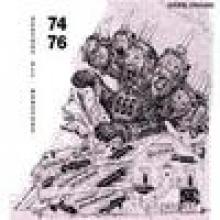Out of the urban/suburban stasis continuing to mount in the Midwest, despite the Stooges and the 5 working to throw it over, Detroit and Ann Arbor remained relatively boring in a music sense. There was no lack of garage cum psych bands. And even the free jazz players of the era were kicking around. In all of this musical expression, there was still a state of scaffolding. Free improv, to an extent, was still burdened by finding the tonic and having everyone play some theme in order to end a composition.
Destroy All Monsters when the group counted Mike Kelley, Jim Shaw, Niagara and Cary Loren as its principals weren’t restrained by ideas pertaining to order. Their music had more to do with the moment of experience and how to express it.
The resulting, unwieldy and at times, difficult to hear early recordings from DAM and some latter day work was assembled in the form of 74-76 a few years back and issued through Ecstatic Peace (Thurston Moore) and Yod Records (Byron Coley) in a joint venture.
The three disc set intersperses some of the more song oriented fair, which finds Niagra attempting to carry a tune in tones somewhere between Nancy Sinatra and Nico, and the noisier works, completely detached from any concept of Western song structure.
“Wahs,” from the collection’s second disc, includes tape loops and a few supplemental sound effects that weren’t really in practice during the mid seventies within rock-related acts. The fact that a pair of Roger Millers’ (Mission of Burma) brothers did time in DAM shouldn’t be a tremendous shock even as the eldest’s career centered on Boston and not the Midwest.
With such an open view of what could or should go into making music, taking on Asheton and Davis eventually moved DAM through to the punk world, which was establishing itself concurrent to this ensemble’s evolution. And as time wore on, DAM’s artsier contingent either checked out, were kicked out or simply became disillusioned enough to stop caring. There’s still some good ‘music’ to wade through, though.
